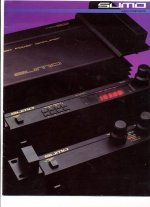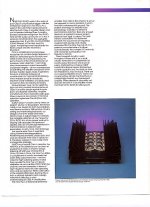Steven said:
that's one interesting amp. Look at how it amplifies the + and - half, with all NPN transistors!
Interesting, isn't it?
millwood said:
that's one interesting amp. Look at how it amplifies the + and - half, with all NPN transistors!
Interesting, isn't it?
But there's a complmentary section having both NPN AND PNP transistors, isn't it? But it is a ciRclotron, yes.
Jan Didden
Some CROWN amps has the same...that's one interesting amp. Look at how it amplifies the + and - half, with all NPN transistors!
Bdeanrembo said:As we sometimes say, even a blind squirel finds a nut occasionally.
the Chinese saying I learnt goes like this "even a blind cat will run into a dead mouse once in a while".
you got a good catch for sure.
text of Sumo description
OCR'd
"NINE PLUS. SUMO's work in the realm of pure Class A amplification began with the company's inception in the
1970's. As a result of this work SUMO quickly became identified with Class A amplifier design; and our first product
utilizing Class A circuitry earned worldwide recognition. The SUMO Gold set the audio community on its ear. It received
accolades from the audiophile reviewing press, it won the coveted STEREO SOUND Product of The Year award in Japan.
And perhaps most importantly, the Gold's unique circuitry received a US patent.
Class A amplification has long been recognized as an ideal design approach. It lends an unstrained quality to music and yields
a sense of uncompromised sonic purity It results in the virtual elimination of crossover notch distortion, It also brings about
improvements in both bandwidth and phase integrity - all as a consequence of operating the amplifier exclusively within its
linear transfer region. Class A operation, however, is typically achieved at considerable cost. Substantial heatsinking and a
massive amplifier chassis are required. Good ventilation and dedicated convection fans are equally necessary.
Serious listeners have had to weigh the high cost and unwieldy inconvenience of Class A amplifier design against its sonic
purity and tubelike sweetness. Amplifier manufacturers have responded with quasi Class A dynamic bias circuits. Other have
opted for higher bias Class B (Class AB) operation.
SUMO's Class A circuitry clearly offers an elegant solution to the problem. Eliminated totally in our design are both bias
instability and thermal runaway With passive circuitry setting and maintaining bias levels, our design is inherently stable and
linear. SUMO's Class A output stage, for example, has negligible distortion at any frequency, 20 Hz to 20 kHz, at any
power level up to clipping with absolutely No feedback applied. (We use only enough feedback in the final analysis to
balance such parameters, as gain, noise, and damping.)
The result is pure Class A operation without thermal tracking problems. Heatsinking requirements, chassis bulk, and cost are
reduced. Pure Class A operation is, therefore, realized in a less costly, more manageable package.
SUMO's most recent Class A amplifier, the Nine Plus, is the beneficiary of our years of experience in Class A amplifier
design. Rated at 65 Watts per channel into B Ohms, 120 into 4 Ohms, the Nine Plus utilizes a complement of twenty
extremely fast super Beta output transistors 97 devices noted for high switching speed. In total they provide the Nine Plus with
power dissipation of an incredible 1000 Watts per channel, and are exemplary in terms of high frequency resolution, safe
operating area, and low distortion. While a derivative of the original SUMO Gold, the Nine Plus is both a product extension
and a design refinement reflecting a clear understanding of Class A amplification. The Nine Plus is a balanced differential
amplifier. Each side of the amplifier is active (as opposed to normal practice, in which one half is referenced to ground). The
positive and negative amplifiers are painstakingly matched to eliminate asymmetrical distortion; then only enough feedback is
applied to ensure perfect balance from input to output. The total linearity and stability thus achieved prevents the occurrence
of frequency overload and slewing, and virtually eliminates TIM. The Nine Plus rolls off at a perfectly controlled rate of 6 dB
per octave (exactly like a simple R-C network) and cannot be overloaded in the frequency domain.
Direct coupled circuitry is used throughout. Phase shift is, as a result, virtually nonexistent. A complement of twenty output
transistors and a power supply anchored by a massive 1.4kW toroidal transformer ensure tremendous current capability and
the ability to drive low impedance, reactive loads. There are no invasive protection circuits. There is no current limiting. All
told, the Nine Plus is a compellingly musical, very transparent amplifier. When stressed it clips softly, yet recovers instantly It
is an amplifier whose sound genuinely belies its rated power.."
OCR'd
"NINE PLUS. SUMO's work in the realm of pure Class A amplification began with the company's inception in the
1970's. As a result of this work SUMO quickly became identified with Class A amplifier design; and our first product
utilizing Class A circuitry earned worldwide recognition. The SUMO Gold set the audio community on its ear. It received
accolades from the audiophile reviewing press, it won the coveted STEREO SOUND Product of The Year award in Japan.
And perhaps most importantly, the Gold's unique circuitry received a US patent.
Class A amplification has long been recognized as an ideal design approach. It lends an unstrained quality to music and yields
a sense of uncompromised sonic purity It results in the virtual elimination of crossover notch distortion, It also brings about
improvements in both bandwidth and phase integrity - all as a consequence of operating the amplifier exclusively within its
linear transfer region. Class A operation, however, is typically achieved at considerable cost. Substantial heatsinking and a
massive amplifier chassis are required. Good ventilation and dedicated convection fans are equally necessary.
Serious listeners have had to weigh the high cost and unwieldy inconvenience of Class A amplifier design against its sonic
purity and tubelike sweetness. Amplifier manufacturers have responded with quasi Class A dynamic bias circuits. Other have
opted for higher bias Class B (Class AB) operation.
SUMO's Class A circuitry clearly offers an elegant solution to the problem. Eliminated totally in our design are both bias
instability and thermal runaway With passive circuitry setting and maintaining bias levels, our design is inherently stable and
linear. SUMO's Class A output stage, for example, has negligible distortion at any frequency, 20 Hz to 20 kHz, at any
power level up to clipping with absolutely No feedback applied. (We use only enough feedback in the final analysis to
balance such parameters, as gain, noise, and damping.)
The result is pure Class A operation without thermal tracking problems. Heatsinking requirements, chassis bulk, and cost are
reduced. Pure Class A operation is, therefore, realized in a less costly, more manageable package.
SUMO's most recent Class A amplifier, the Nine Plus, is the beneficiary of our years of experience in Class A amplifier
design. Rated at 65 Watts per channel into B Ohms, 120 into 4 Ohms, the Nine Plus utilizes a complement of twenty
extremely fast super Beta output transistors 97 devices noted for high switching speed. In total they provide the Nine Plus with
power dissipation of an incredible 1000 Watts per channel, and are exemplary in terms of high frequency resolution, safe
operating area, and low distortion. While a derivative of the original SUMO Gold, the Nine Plus is both a product extension
and a design refinement reflecting a clear understanding of Class A amplification. The Nine Plus is a balanced differential
amplifier. Each side of the amplifier is active (as opposed to normal practice, in which one half is referenced to ground). The
positive and negative amplifiers are painstakingly matched to eliminate asymmetrical distortion; then only enough feedback is
applied to ensure perfect balance from input to output. The total linearity and stability thus achieved prevents the occurrence
of frequency overload and slewing, and virtually eliminates TIM. The Nine Plus rolls off at a perfectly controlled rate of 6 dB
per octave (exactly like a simple R-C network) and cannot be overloaded in the frequency domain.
Direct coupled circuitry is used throughout. Phase shift is, as a result, virtually nonexistent. A complement of twenty output
transistors and a power supply anchored by a massive 1.4kW toroidal transformer ensure tremendous current capability and
the ability to drive low impedance, reactive loads. There are no invasive protection circuits. There is no current limiting. All
told, the Nine Plus is a compellingly musical, very transparent amplifier. When stressed it clips softly, yet recovers instantly It
is an amplifier whose sound genuinely belies its rated power.."
- Status
- This old topic is closed. If you want to reopen this topic, contact a moderator using the "Report Post" button.
- Home
- Amplifiers
- Solid State
- SUMO Power Amp

